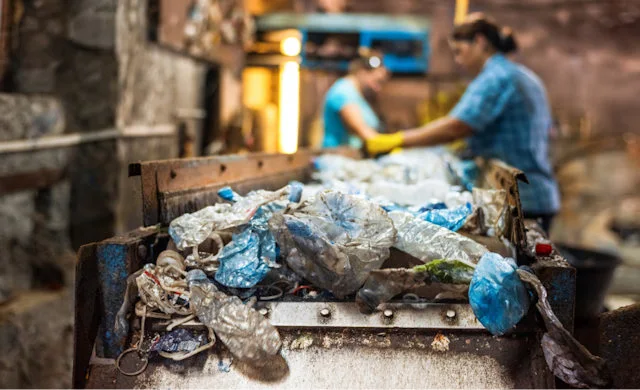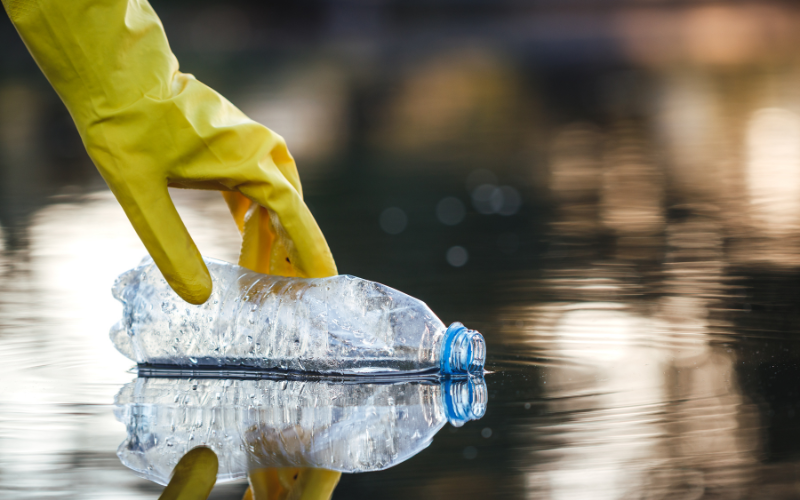At Biovie, environmental concerns have always been at the heart of our business. In the coming years, companies will need to offset their use of plastic to encourage the adoption of more sustainable, ethical, and eco-friendly options. We are not zero waste nor no-plastic, but we approach this issue with awareness.
We have decided to start offsetting our plastic usage by purchasing plastic credits from Corsair, which will remove from the environment the same amount of plastic that we use each year. This is to be among the first French companies to achieve plastic neutrality.
Plastic waste will be transformed into new plastic sourced through pyrolysis. This technique paves the way for recycling in a circular economy, an alternative to landfilling and incineration, both of which are harmful to humans and the earth.
In this comprehensive article, we will talk to you about plastic credit, which is an innovative concept that is gaining popularity in the field of environmental responsibility. This approach offers a new perspective on managing plastic waste and reducing our ecological footprint. We will explore the ins and outs of plastic credit, as well as its potential impact on the environment.
After reading this article, you will have:
- A clear understanding of the concept of plastic credit,
- Information about key actors such as Amplivo and Corsair,
- An overview of innovative techniques such as upcycling and pyrolysis,
- Practical tips for participating in this ecological initiative.

What is plastic credit ?
Plastic credit is an innovative approach aimed at countering the harmful effects of plastic pollution by establishing a compensation system. Inspired by carbon credit mechanisms, this method allows companies and individuals to "offset" their plastic usage by funding projects for pollution cleanup and comprehensive plastic recycling. The central idea is to balance the plastic footprint by actively contributing to initiatives that remove as much, or even more, plastic than is used.
The functioning of plastic credit relies on the collaboration between various actors in the environmental sector. Pioneering companies in the field, such as the industrial... Corsair and its subsidiary Amplivo For example, they play a crucial role in integrating these credits into their corporate social responsibility strategies. Amplivo is committed to supporting large-scale pollution cleanup projects, while Corsair is implementing programs to reduce plastic waste and setting up plants to process collected plastic through pyrolysis.
The environmental impact of plastic credit
Plastic credit has significant potential to mitigate the disastrous effects of plastic pollution. By implementing this compensation system, we can make a tangible contribution to reducing plastic waste that is invading our oceans and landscapes. This mechanism not only encourages the cleaning of polluted environments but also prevention by limiting the excessive use of plastic.
One of the main advantages of plastic credit is its ability to support the circular economy. By funding projects for comprehensive plastic collection and recycling, we transform waste into new virgin resources, thereby minimizing the need for raw materials. This approach promotes an extended life cycle for plastic, reducing the ecological footprint associated with its production and end-of-life management.
By participating in plastic credit, companies can not only offset their consumption but also encourage a greener economy. This creates a positive synergy where each action contributes to a broader environmental impact, paving the way for more responsible consumption and a healthier planet.

Technologies at the service of plastic credit
In the fight against plastic pollution, technological innovation plays a crucial role. Advancements such as the Pyrolysis and upcycling offer promising solutions to transform our waste into valuable resources. These innovative techniques are at the heart of plastic credit, promoting more sustainable waste management and fostering a circular economy.
These advanced technologies do not just process plastic waste; they transform our way of thinking about consumption and sustainability.
Visit to the very first historic Corsair factory in Bangkok, Thailand:
Pyrolysis: Transforming Plastic into a Resource
The Pyrolysis is an innovative technology that plays a crucial role in managing plastic waste recycling. This process involves heating the plastic to a high temperature in the absence of oxygen, which allows the polymers to break down into usable hydrocarbons, such as theoil pyrolysis. This technique offers a promising solution to reduce the amount of plastic that ends up in landfills or oceans while providing an alternative to traditional fossil fuels.
Pyrolysis oil, the main result of this process, can be reused in several ways. It can be converted into fuel, providing a renewable energy source that can help reduce our dependence on virgin oil resources, but this is not its most noble use. This oil can primarily serve as a raw material for manufacturing new plastic products.
This transformation process offers several environmental benefits. It reduces greenhouse gas emissions associated with the incineration of plastic waste and limits plastic pollution by diverting these materials from landfills.. Furthermore, by valorizing used plastics, pyrolysis represents a significant environmental action, helping to reduce the exploitation of natural resources for the production of new plastic, which aligns with the principles of sustainability and ecological responsibility.
Upcycling: Giving a New Life to Plastic
Upcycling is an innovative approach that involves transforming plastic waste into products with equal or greater value than the original raw materials.. Unlike traditional recycling, which can degrade the quality of the material, Upcycling preserves and even enhances the potential of used plastics, thus giving them a new life.
For example, thanks to upcycling, a simple plastic bottle can be transformed into unique fashion accessories, designer furniture, or even construction materials. This technique encourages creativity and innovation by reimagining the possible applications of materials., while reducing the carbon footprint associated with the production of new plastics.
The advantages of upcycling compared to traditional recycling are numerous. Firstly, it often requires less energy since the material does not undergo a degradation process followed by a complete reformation. Furthermore, by creating higher quality products, upcycling adds value to waste, which can increase the economic attractiveness of ecological initiatives and encourage a wider adoption of sustainable practices.

How to get involved in plastic credit ?
Engaging in plastic credit is an approach accessible to any company wishing to integrate sustainable practices. This innovative approach allows for offsetting one's plastic footprint by funding projects that contribute to the depollution and recycling of plastic waste.
Integrate plastic credit into the strategy of corporate social responsibility (CSR) has become a major asset for those who wish to demonstrate their commitment to the environment. This involves offsetting the use of plastic by supporting depollution and full recycling projects. Companies that engage in this approach can not only reduce their ecological footprint but also strengthen their brand image among consumers who are increasingly concerned about environmental issues.
The future of plastic credit
The future of plastic credit looks promising, and this approach is gaining traction as a viable solution for managing plastic waste. By relying on compensation systems similar to carbon credits, plastic credit aims to balance our footprint by funding depollution and comprehensive recycling initiatives.
Towards Plastic Neutrality
The plastic neutrality is an ambitious goal that aims to balance the quantities of plastic produced with the quantities recovered and recycled, without a net increase in plastic waste in the environment. Similar to carbon neutrality, this approach focuses on the reduction, compensation, and elimination of plastic waste in order to reach a balance point where plastic production does not generate residual pollution.
To achieve this goal, it is crucial to implement integrated strategies that include source reduction, intensified recycling, and support for depollution projects. Companies can play a pivotal role by adopting more sustainable manufacturing practices and participating in plastic credit systems. This involves a transition to alternative materials and innovative technologies, such as upcycling and pyrolysis, to recover value from existing plastic waste.
However, achieving plastic neutrality presents several challenges. One of the main ones is the establishment of adequate infrastructure for recycling, large-scale depollution, and the conversion of waste into pyrolysis oil. To date, there are fewer than ten sites worldwide that allow for this conversion.
An emerging technology is the biotechnology, which uses microorganisms to break down plastic into biodegradable components. This approach could radically transform the way we approach recycling by reducing reliance on energy-intensive processes and offering a more eco-friendly solution to plastic pollution. Research is currently underway to improve the efficiency of these microorganisms, and the initial results are promising.
Moreover, The use of artificial intelligence in sorting plastic waste shows enormous potential for increasing the efficiency of recycling. Intelligent sorting systems can automatically identify and separate different types of plastics, thereby improving the quality of recycled materials. This could not only reduce processing costs but also maximize the amount of plastic that can be reused in the production of new products.
The development of alternative and compostable materials also represents a promising avenue. Bio-based plastics, made from renewable raw materials, offer an alternative to traditional petroleum-derived plastics. Although they do not entirely solve the problem of plastic waste, their increasing use could reduce the demand for conventional plastics and promote more environmentally friendly life cycles.
Conclusion
Plastic credit emerges as an innovative solution to tackle plastic pollution and promote a more sustainable management of our resources. By balancing the use of plastic through the financing of depollution and comprehensive recycling projects, this approach offers a concrete path towards a significant reduction of our environmental footprint. If you are a business and you also wish to get involved, You can buy plastic credits from Amplivo, a subsidiary of Corsair.
Each individual also has a role to play in this transition towards plastic neutrality. By reducing our personal consumption, choosing responsible products, and participating in offset programs, we actively contribute to positive change. The collective effort, whether individual or organizational, is essential for moving towards an environmentally respectful future.
For those who wish to stay informed about the latest ecological advancements and discover practical tips for a more responsible lifestyle, subscribe to our newsletter is an excellent way to receive relevant and inspiring information. Together, we can make a difference and move towards a more sustainable economic and societal model.
Your questions and our answers (FAQ)
What is plastic credit and why is it important ?
Plastic credit is a compensation system inspired by carbon credits, aimed at balancing our plastic footprint by funding depollution and full recycling projects. It is crucial because it helps reduce plastic pollution, encourages sustainable resource management, and promotes the circular economy, which is essential for the protection of our environment.
What are the environmental benefits of plastic credits ?
Plastic credit helps reduce the amount of plastic waste in our oceans and landscapes. It supports the circular economy by transforming waste into reusable resources, which decreases the reliance on virgin raw materials. This method also reduces greenhouse gas emissions related to the production and management of plastics, thereby promoting a more positive environmental impact.
What innovative technologies are used in the context of plastic credit ?
Technologies such as pyrolysis and upcycling are at the heart of plastic credit. Pyrolysis breaks down plastics into pyrolysis oil, an alternative to fossil fuels. Upcycling transforms plastic waste into products of equal or greater value. These innovative technologies enable more sustainable waste management and support the development of a circular economy.
How can I personally get involved in plastic credit ?
Reduce your plastic consumption by using reusable products and choosing sustainable brands. Participating in plastic offset programs is also an excellent way to support pollution cleanup projects. Every individual action counts and contributes to a collective effort to reduce our plastic footprint. You can also join the Amplivo program by purchasing plastic credits that will enable the removal of plastics from the environment.
What is the goal of plastic neutrality and how can it be achieved ?
Plastic neutrality aims to balance plastic production with an equivalent amount of plastic recovered and recycled, thereby avoiding a net increase in plastic waste. To achieve this, it is necessary to reduce plastic consumption, intensify recycling, and support pollution cleanup projects. Collaboration between businesses, individuals, and governments is essential to achieve this ambitious goal.
What future innovations could transform plastic waste management ?
Future innovations include biotechnology, which uses microorganisms to biodegrade plastic, and artificial intelligence to improve waste sorting. Alternative and compostable materials are also in development. These advancements promise to enhance recycling efficiency and reduce the environmental impact of plastic.



